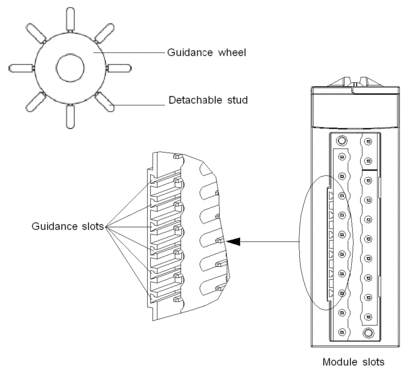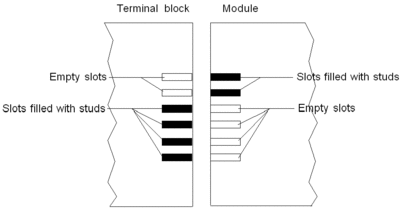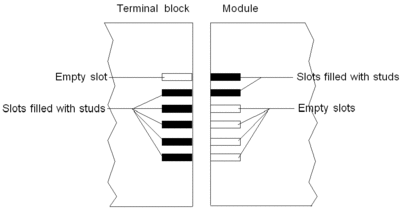At a Glance
The modules with 20-pin terminal block connections require the terminal block to be connected to the module. These fitting operations (assembly and disassembly) are described below.
| DANGER | |
|---|---|
| CAUTION | |
|---|---|
Installing the Terminal Block
The following table shows the procedure for assembling the 20-pin terminal block onto a discrete input/output module.

Assembly Procedure
Step |
Action |
|---|---|
1 |
Once the module is in place on the rack, install the terminal block by inserting the terminal block encoder (the rear lower part of the terminal) into the module's encoder (the front lower part of the module), as shown above. NOTE: The module connector have indicators which show the proper
direction to use for terminal block installation.
|
2 |
Fix the terminal block to the module by tightening the 2 mounting screws located on the lower and upper parts of the terminal block. Tightening torque: 0.4 N•m (0.30 lbf-ft). |
Coding the 20-Pin Terminal Block
| WARNING | |
|---|---|
| CAUTION | |
|---|---|
When a 20-pin terminal block is installed on a module dedicated to this type of terminal block, you can code the terminal block and the module using studs. The purpose of the studs is to prevent the terminal block from being mounted on another module. Incorrect insertion can then be avoided when replacing a module.
Coding is done by the user with the STB XMP 7800 guidance wheel’s studs. You can only fill the 6 slots in the middle of the left side (as seen from the wiring side) of the terminal block, and can fill the module’s 6 guidance slots on the left side.
To fit the terminal block to the module, a module slot with a stud must correspond to an empty slot in the terminal block, or a terminal block with a stud must correspond to an empty slot in the module. You can fill up to and including either of the 6 available slots as desired.
The diagram below shows a guidance wheel as well as the slots on the module used for coding the 20-pin terminal blocks.

The diagram below shows an example of a coding configuration that makes it possible to fit the terminal block to the module.

The diagram below shows an example of coding configuration with which it is not possible to fit the terminal block to the module.



